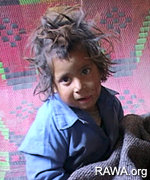KABUL - About 600 children under five die every day in Afghanistan due to pneumonia, poor nutrition, diarrhoea and other preventable diseases, according to the State of the World’s Children 2008 report released by the UN Children’s Fund (UNICEF) on 22 January.
Entitled Child Survival, the UNICEF report ranks Afghanistan as having the third highest infant mortality rate, after Sierra Leone and Angola. The country is ranked second in the world in terms of its maternal mortality rate with about 1,600 deaths per every 100,000 live births.
The war-ravaged country has made considerable progress in the delivery of basic health services to about 80 percent of its estimated 24.5 million population which has reduced child mortality rates by 25 percent since 2001, UNICEF said.
However, one out of every four Afghan children does not survive his/her fifth birthday, aid agencies say.
Afghanistan’s overall progress towards its fourth Millennium Development Goal which calls for a 50 percent reduction in the infant mortality rate by 2015, is deemed “very difficult” given the country’s multiple challenges.
Launching the global report in Kabul, Dan Toole, UNICEF regional director in South Asia, said: “Afghanistan cannot walk with child survival [efforts], it should run”.
Lack of clean drinking water, sanitation
Poor access to safe drinking water and sanitation is another major cause of death among many Afghan women and children.
Only five million Afghans use clean drinking water and 2.6 million have access to sanitation, Toole told reporters.
Pneumonia and diarrhoea are the two most serious diseases among under fives, according to the report.
In Afghanistan, only 28 percent of children suffering from pneumonia reach an appropriate health-care provider, while 48 percent of those with diarrhoea receive “oral rehydration and continued feeding”.
Meanwhile, only 14 percent of pregnant women in Afghanistan receive a “skilled attendant” during child delivery.
More than half of 6-9-month-old children in Afghanistan are deprived of proper breastfeeding and complementary food. This has resulted in 39 percent of under fives being underweight and 54 percent of them suffering stunting or improper physical growth, UNICEF’s statistics indicate.
Education
In a speech to the Afghan National Assembly on 21 January President Hamid Karzai acknowledged that the Taliban insurgency had deprived at least 300,000 children of attending school in southern provinces.
The primary school attendance ratio in Afghanistan was estimated at 40 percent for females and 66 percent for males in 2000-2006, according to UNICEF indicators. The ratio for secondary school attendance in the same period goes down to 18 percent for males and only six percent for females.




